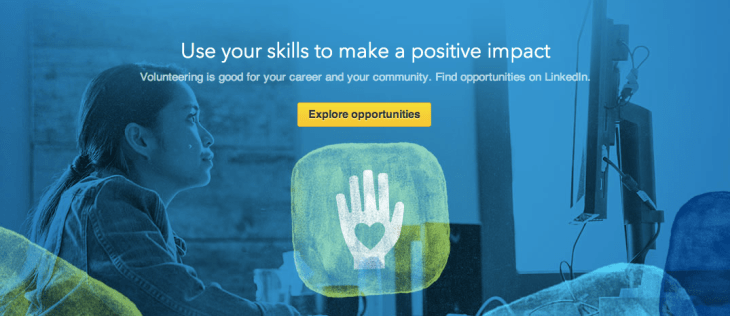LinkedIn, the social network for the working world, has gained a reputation as a place to go when you’re looking for a job, or a person to fill a vacant role. Now the company is expanding on that idea with the launch of a Volunteer Marketplace — a place people can go to post and look for unpaid positions. The site is live now, with openings ranging from asking for help with web development at nonprofits like Hire Our Heroes through to a request for a voluntary board member (with fundraising experience) at the United Way of San Luis Obispo.
But even if the marketplace will focus on unpaid work and is currently limited to U.S. 501c3 nonprofits, posting in the marketplace will not be free: I went through the process of posting a job on the marketplace a moment ago, and in the UK (where I am based and LinkedIn automatically redirects me on all paid matters) a single, 30-day posting costs around $20 (at a current 90% discount); a five-job pack costs around $164 per job; a 10-job pack costs $132 per job (the rates seem to vary depending on where I post the job).
“Yes, we are charging a nominal fee to help with quality and fraud control when you post,” a spokesperson told me. “We are investing all revenue directly back to the nonprofit sector, to increase the liquidity of the postings.”
Launching a volunteer marketplace makes sense for a few reasons:
— LinkedIn is currently courting more students to sign up, with an expansion of its university pages and now the ability for people as young as 14 to create accounts. Volunteer positions, which could include internships or other work experience, are a key way of getting those younger users to engage more in LinkedIn.
— It is a way to get people who are not actively looking for paid work to keep using LinkedIn to expand their horizons.
“When I talk with LinkedIn members, many tell me they aren’t actively looking for traditional job opportunities,” writes Reid Hoffman, co-founder and chairman of LinkedIn, writes in a blog post up today. “Instead, they want to hone or leverage their skills while also making a positive impact on the world.”
— It’s a way of helping out a sector that really needs it. The cynics among you might think that LinkedIn is simply looking for a way to drive up its position as a place for recruitment, whatever the nature of it. Talent solutions — the division of the company that covers job listings and related paid products — generated 57% of its $393 million in revenues, or $224 million, in the last fiscal quarter. On the other hand, the area of volunteering, particularly for non-profits, is massively undersubscribed, with a recent study from the Taproot foundation noting that 92% of nonprofits are currently on the hunt for volunteers to fill roles.
— It also fits in with a part of LinkedIn’s existing aggregation of profile data. When users create and update their profiles on the site, along with professional experience, you can (just as you do on a resume) include charitable and other non-paid interests in the Volunteer and Causes part of their profiles. Some three million members have added this information to their profiles. Hoffman writes that some 600,000 have indicated they would like to serve on boards or do other skills-based volunteering.
Adding in a marketplace to serve that need not only makes entering that kind of information more relevant, but it increases the chances that more will do so — right now there are more than 259 million members, so three million is not exactly a huge proportion.
Although there are already organizations like CatchAFire built to connect professionals with volunteering opportunities, the fact that we are largely talking about a fundamentally low-margin business like non-profits means that there is usually less attention paid to these kinds of platforms. Coupling a marketplace for unpaid positions to one that already gets a lot of traffic for paid positions could see a boost of attention for volunteering. In fact, CatchAFire, along with the Taproot Foundation, BoardSource and VolunteerMatch are all partnering with LinkedIn for the service — with LinkedIn serving as a kind of aggregator.
Right now, if you look at the listings on the marketplace, all come from non-profit organizations. I am asking whether that will remain the case longer term or whether LinkedIn plans to add other unpaid work like internships or other work at profit-generating companies. Such a move could potentially raise the question of whether LinkedIn encourages unpaid work at the expense of companies offering fair remuneration for a job done, no matter how small it is. (Update: looks like it is only nonprofits for now, according to a spokesperson.)
